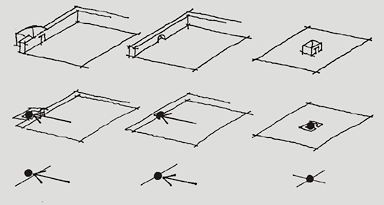
| Shelter
in green: shelter in rough stone, red soil and
green are the elements of environment with all components
of sustainability in the nature. (Kazun (Istra),
Croatia) |
|
In the environment stone appears
completely natural: although a building is the product of
human labour, it is harmonised with nature and pleasant
to behold. Thus walls, but also smaller buildings and
shelters, are built in human scale and don't stand out in
their settings. They merge with them and give added value.
The buildings as such are positioned in the environment harmoniously
or in contrast. Both possibilities give the setting added
value: the first is less contesting, while the latter demands
more knowledge, feeling and culture.
Effects caused by introducing stone constructions into
natural environments are manifold:
- controlled use of vegetation stimulates its' growth, but
also raises its' quality;
- local materials merge with the environment, and are unobtrusive;
- utility of the environment as such increases with controlled
use;
- new elements can present harmonious spatial emphasis, unobtrusively
and more successfully.

| Position
of shelter: shelter can be placed out of the
wall, in the wall or in the middle of the field
or enclosed pasture |
|
Shelters as the most elementary
and typical architecture can be positioned in space:
- independently, when buildings have no interactive relations;
- in groups, when they form architectural ensembles, farmsteads;
- in clusters, when they present a dense, newly settled space;
- densely, when objects of vernacular architecture form villages
or towns.
Whatever the form these buildings built in the dry-wall technique
assume, they are so close to nature that they become its'
part and although created by humans they are not alien.
|